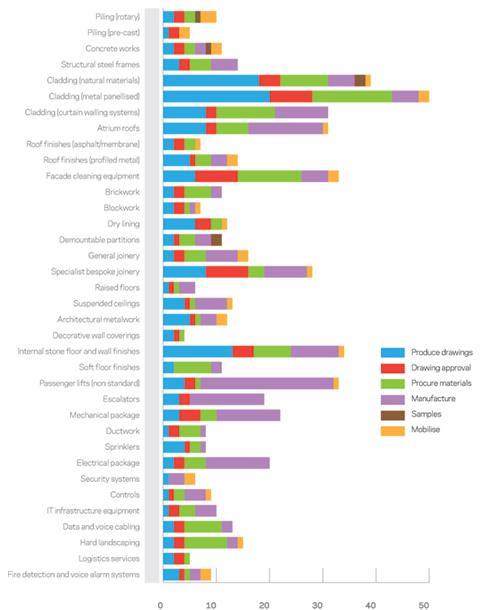There are capacity issues with some off-site manufacturing but the consensus among other site-based trades is that lead times are stabilising
01 / Going up
▲ Concrete works
▲ Cladding – metal panellised system
▲ Specialist joinery
▲ Passenger lift-non standard
02 / Staying Level
▶ Rotary piling
▶ Pre-cast piling
▶ Structural steel frames
▶ Cladding (natural materials)
▶ Cladding (metal panellised system)
▶ Cladding (curtain walling system)
▶ Atrium roof
▶ Roof finishes (asphalt / membrane)
▶ Roof finishes (profiled metal)
▶ Facade cleaning equipment
▶ Brickwork
▶ Blockwork
▶ Drylining
▶ Demountable partitions
▶ General joinery
▶ Raised floors
▶ Suspended ceilings
▶ Architectural metalwork
▶ Decorative wall coverings
▶ Internal stone floor and wall finishes
▶ Soft floor finish
▶ Esclator
▶ Electrical package
▶ Mechanical package
▶ Ductwork
▶ Sprinklers
▶ Security systems
▶ Controls
▶ IT infrastructure equipment
▶ Data and voice cabling
▶ Hard landscaping
▶ Logistics services
03 / Going Down
▼ Fire detection and voice alarm systems
04 / Lead times summary
Rotary piling ▶ firms are reporting no change in lead times for this quarter and lead time remains at 10 weeks. Demand in the next six months is stable. Contractors report a shortage of rigs which may impact future lead times. Pre-cast piling ▶ lead time remains at five weeks. PFA shortage means potential for future increases in lead times for both rotary and precast piling.
Concrete works ▶ lead times increased by one week to 11 weeks. Contractors do not anticipate increases over the next six months.
Structural steel frames ▶ lead time remains at 14 weeks. Change is not anticipated in the next six months.
Cladding (natural material) ▶ lead time remain at 39 weeks for the third quarter in succession. Companies do not anticipate increases in the next six months. Cladding (metal panellised system) ▲ lead times have increased by five weeks to 50 weeks. Contractors anticipate further increases in the next six months. Cladding (curtain walling system) ▶ lead times remain at 31 weeks. Contractors do not anticipate increases over the next six months.
Atrium roof ▶ lead times remain at 31 weeks.
Roof finishes (asphalt / membrane) ▶ lead times remain at seven weeks. Contractors do not anticipate increases in the next six months. Roof finishes (profiled metal) ▶ lead times have remained at 14 weeks for over a year. No increase anticipated in the next six months.
Facade cleaning equipment ▶ lead times remain at 33 weeks. Contractors anticipate lead time will remain the same over the next six months.
Brickwork ▶ lead times remain at 11 weeks. No changes anticipated over the next six months.
Blockwork ▶ lead time remains at seven weeks. Firms do not expect increases over the next six months.
Drylining ▶ lead time remains at 12 weeks. No increases anticipated in the next six months.
Demountable partitions ▶ lead times remain at 11 weeks. No increases anticipated over next six months.
General joinery ▶ lead times remains at 16 weeks for the third quarter in succession. Anticipated longer lead times did not materialise. No further increases are anticipated in the next six months. Specialist joinery ▲ lead times increased by a further three weeks to 28 weeks. Further increases are anticipated.
Raised floors ▶ lead time remains at six weeks.
Suspended ceiling ▶ lead time remains at 13 weeks. No increase forecast for the next six months.
Architectural metalwork ▶ remains at 12 weeks following an increase by one week six months ago. No further increases anticipated.
Decorative wall covering ▶ lead times remain at four weeks. No change anticipated in the next six months.
Internal stone floor ▶ and wall finish lead time remains at 34 weeks. No increases are anticipated in the next six months. Soft floor finish ▶ lead time remains at 11 weeks following increases nine months ago. Previously forecast increases have not materialised. No further increases anticipated in the next six months.
Passenger lift-non standard ▲ lead time has increased by a further week following the two week increase last quarter taking lead time to 32 weeks. No further change in lead time forecast for the next six months.
Escalator ▶ lead times remain at 19 weeks. No change forecast for the next six months.
Electrical package ▶ lead times remain at 20 weeks following last quarter increase of three weeks. No increase forecast in the next six months.
Mechanical packages ▶ the steady increase in lead times has stabilised at 22 week this quarter. Contractors note potential for increases in the next six months.
Ductwork ▶ lead time remains at eight weeks. No change forecast for the next six months.
Sprinklers ▶ lead time remains at eight weeks. Firms do not forecast an increase over the next six months.
Security systems ▶ lead time remains at six weeks.
Controls ▶ lead time has stabilised at nine weeks following the fluctuations over the past six months. No further increases anticipated over the next six months.
IT infrastructure equipment ▶ remains at 10 weeks.
Data and voice cabling ▶ remains at 13 weeks.
Fire detection and voice alarm systems ▼ lead time has reduced by two weeks to nine weeks with contractors anticipating increased capacity over the next six months.
Hard landscaping ▶ lead time remains at 15 weeks. No change anticipated in the next six months.
Logistics services ▶ lead time remains at five weeks. No change forecast in the next six months.
Specialist contractors with a high percentage of off-site manufacturing are reporting capacity issues driving up lead times. However, the consensus among other site-based trades appears to be that the specialist contractor market is levelling off over the next six months leading to more stable lead times.

Data capture and analysis by Mace Business School. For more details on the article and contributors, please visit
























No comments yet